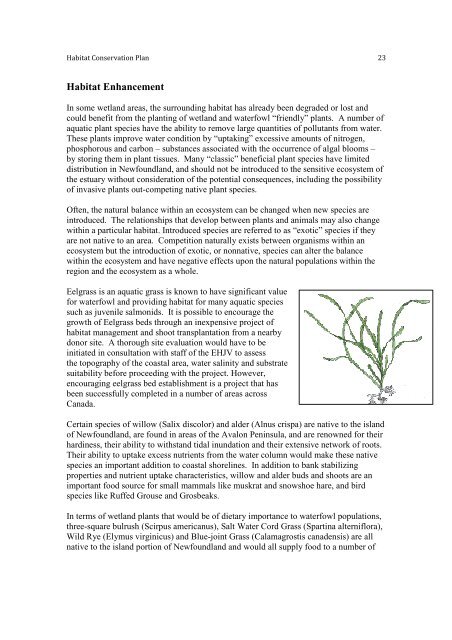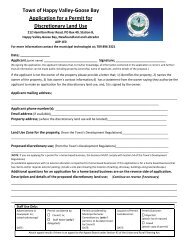Habitat Conservation Plan Habitat Conservation Plan for the Town ...
Habitat Conservation Plan Habitat Conservation Plan for the Town ...
Habitat Conservation Plan Habitat Conservation Plan for the Town ...
- No tags were found...
Create successful ePaper yourself
Turn your PDF publications into a flip-book with our unique Google optimized e-Paper software.
<strong>Habitat</strong> <strong>Conservation</strong> <strong>Plan</strong> 23<strong>Habitat</strong> EnhancementIn some wetland areas, <strong>the</strong> surrounding habitat has already been degraded or lost andcould benefit from <strong>the</strong> planting of wetland and waterfowl “friendly” plants. A number ofaquatic plant species have <strong>the</strong> ability to remove large quantities of pollutants from water.These plants improve water condition by “uptaking” excessive amounts of nitrogen,phosphorous and carbon – substances associated with <strong>the</strong> occurrence of algal blooms –by storing <strong>the</strong>m in plant tissues. Many “classic” beneficial plant species have limiteddistribution in Newfoundland, and should not be introduced to <strong>the</strong> sensitive ecosystem of<strong>the</strong> estuary without consideration of <strong>the</strong> potential consequences, including <strong>the</strong> possibilityof invasive plants out-competing native plant species.Often, <strong>the</strong> natural balance within an ecosystem can be changed when new species areintroduced. The relationships that develop between plants and animals may also changewithin a particular habitat. Introduced species are referred to as “exotic” species if <strong>the</strong>yare not native to an area. Competition naturally exists between organisms within anecosystem but <strong>the</strong> introduction of exotic, or nonnative, species can alter <strong>the</strong> balancewithin <strong>the</strong> ecosystem and have negative effects upon <strong>the</strong> natural populations within <strong>the</strong>region and <strong>the</strong> ecosystem as a whole.Eelgrass is an aquatic grass is known to have significant value<strong>for</strong> waterfowl and providing habitat <strong>for</strong> many aquatic speciessuch as juvenile salmonids. It is possible to encourage <strong>the</strong>growth of Eelgrass beds through an inexpensive project ofhabitat management and shoot transplantation from a nearbydonor site. A thorough site evaluation would have to beinitiated in consultation with staff of <strong>the</strong> EHJV to assess<strong>the</strong> topography of <strong>the</strong> coastal area, water salinity and substratesuitability be<strong>for</strong>e proceeding with <strong>the</strong> project. However,encouraging eelgrass bed establishment is a project that hasbeen successfully completed in a number of areas acrossCanada.Certain species of willow (Salix discolor) and alder (Alnus crispa) are native to <strong>the</strong> islandof Newfoundland, are found in areas of <strong>the</strong> Avalon Peninsula, and are renowned <strong>for</strong> <strong>the</strong>irhardiness, <strong>the</strong>ir ability to withstand tidal inundation and <strong>the</strong>ir extensive network of roots.Their ability to uptake excess nutrients from <strong>the</strong> water column would make <strong>the</strong>se nativespecies an important addition to coastal shorelines. In addition to bank stabilizingproperties and nutrient uptake characteristics, willow and alder buds and shoots are animportant food source <strong>for</strong> small mammals like muskrat and snowshoe hare, and birdspecies like Ruffed Grouse and Grosbeaks.In terms of wetland plants that would be of dietary importance to waterfowl populations,three-square bulrush (Scirpus americanus), Salt Water Cord Grass (Spartina alterniflora),Wild Rye (Elymus virginicus) and Blue-joint Grass (Calamagrostis canadensis) are allnative to <strong>the</strong> island portion of Newfoundland and would all supply food to a number of






